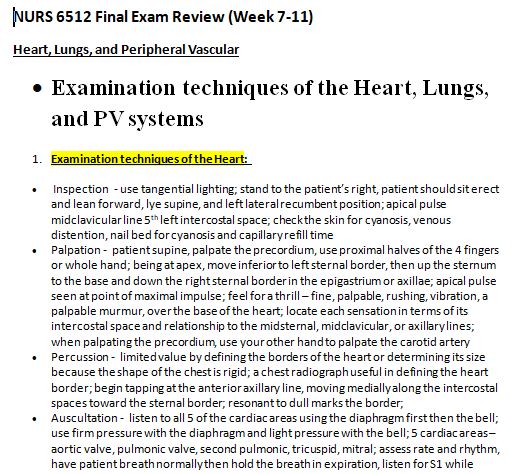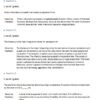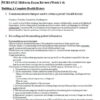Description
NURS 6512N Final Exam Review (Week 7-11) – 36 Pages
Heart, Lungs, and Peripheral Vascular
- Examination techniques of the Heart, Lungs, and PV systems
- Examination techniques of the Heart:
- Examination-techniques of the lungs:
- Examination-techniques of the peripheral vascular system:
- Examination findings of arterial blood flow in infants
- Description of types of shortness of breath (orthopnea, platypnea. Tachypnea, bradypnea)
- Examination findings of the heart and lungs in a patient with illegal drug use
- Symptoms associated with intrathoracic infection
- Percussion techniques when examining the lungs
- Examination findings when percussing the lungs
- Cardiac examination findings for a patient with rheumatic fever
- Grading of heart murmurs
- Evaluation of ECG tracings
- Examination technique for the apical pulse
- Examining technique for different cardiac sounds and their names
- Varicosity findings in pregnant women
- Examination of peripheral arteries
- Grading of pulses
- Examination findings of a child with Kawasaki disease
- Examination findings of a child with Kawasaki disease (Dains et al, 2016, p. 2015) (Ball et al, 2016, p. 349)
- Examination findings of a patient with peripheral edema
- Examination findings of a patient with peripheral edema (Dains et al, 2016, p. 166) (Ball et al, 2015, p.344)
- Examination of ammonia in breath odor
- Examination of ammonia in breath odor (Ball et al, 2015, p. 274 & 409)
Assessing Musculoskeletal Pain
- Diagnostic tests for patients with carpal tunnel
- DIAGNOSTIC TESTS FOR PATIENTS WITH CARPAL TUNNEL
- Examination techniques used for muscle and joint pain
- Spinal deformities noted during examination
- Characteristic examination findings for Rheumatoid Arthritis
- Orthopedic screening evaluation techniques
- Characteristic examination findings consistent with Osteoarthritis
- Characteristic examination findings consistent with Gout
Assessment of Cognition and the Neurologic System
- Significance of the Denver II tool
- Examination of the mental status
- Examination findings associated with Attention Deficit Hyperactivity Disorder (ADHD)
- Behavior patterns of a patient with Schizophrena, Depression, Anxiety, and Mania
- Examination findings of a patient with Diabetic Peripheral Neuropathy
- Examination findings of all Cranial Nerves
- Deep Tendon Reflex evaluation nurs 6512n final exam
- Examination techniques of all Cranial Nerves
- Examination technique and findings for nuchal rigidity
Assessing the Genitalia and Rectum Case Study
- Significance of Montgomery tubercles
- Examination findings of breast changes during menopausal
- Examination findings consistent with breast cancer in females
- Proper technique for using a speculum during the vaginal exam
- Proper technique for the bimanual examination
- Risk factors for testicular cancer
- Proper technique for examining the male genitalia, including the prostate
- Normal vs abnormal bowel findings in newborns
- Risk factors for colorectal cancer nurs 6512n final exam
- Examination findings consistent with Benign Prostate Hypertrophy
- Examination findings consistent with Prostate Cancer
- Characteristics of menopausal disorder
- Examination position when assessing anal sphincter tone
- Characteristics of Pelvic Inflammatory Disease
- Characteristics of Hydrocele, Epididymitis, Epispadias, and Hypospadias
The Ethics Behind Assessment
- Ethical considerations when completing adolescent sports physicals with no injuries vs adolescents with previous injuries
- Diagnostics tests used to evaluate sports injuries nurs 6512n final exam
- Examination of children with heart murmurs when conducting a sports physical
- Ethical considerations to be made as Advanced Practice Registered Nurse








